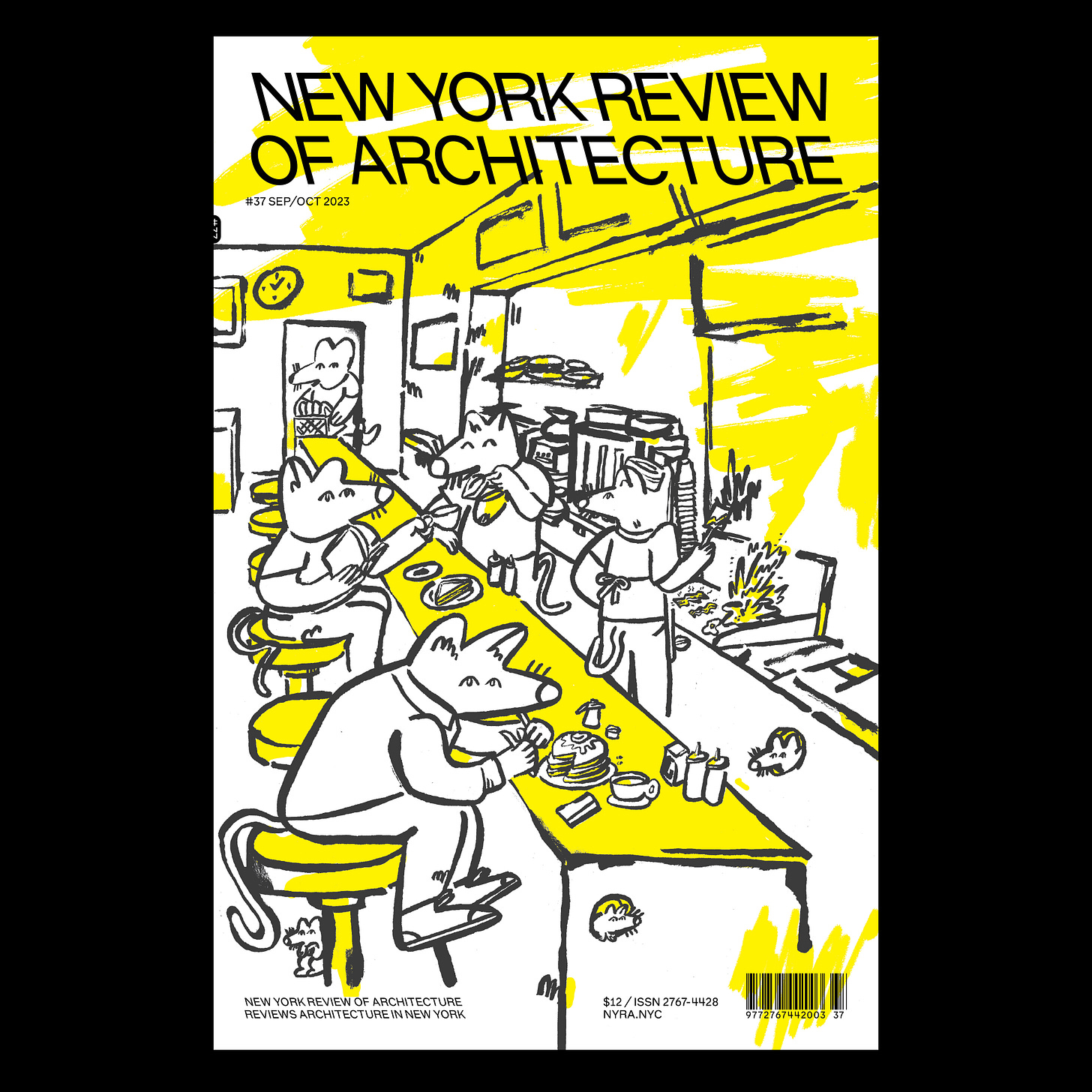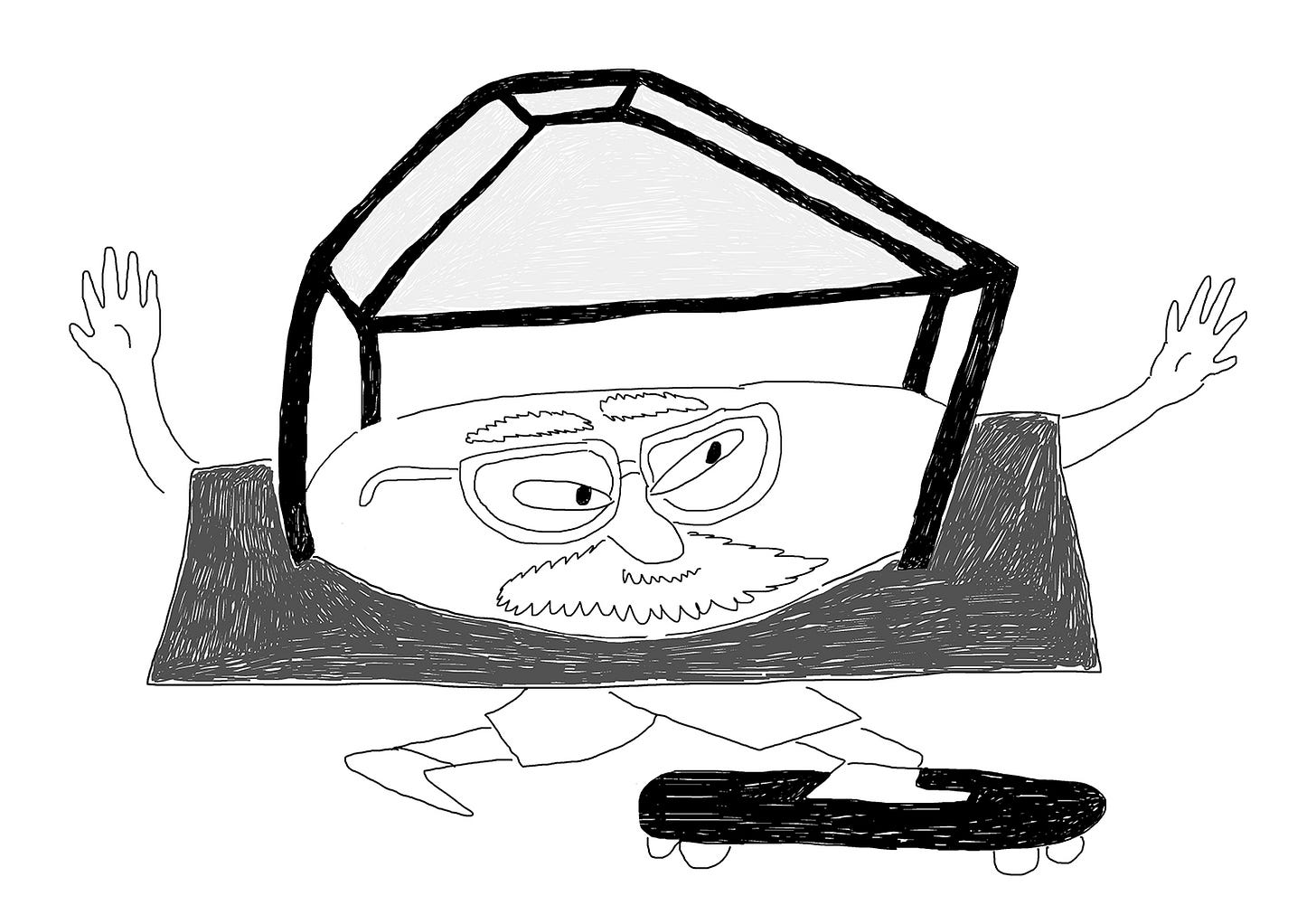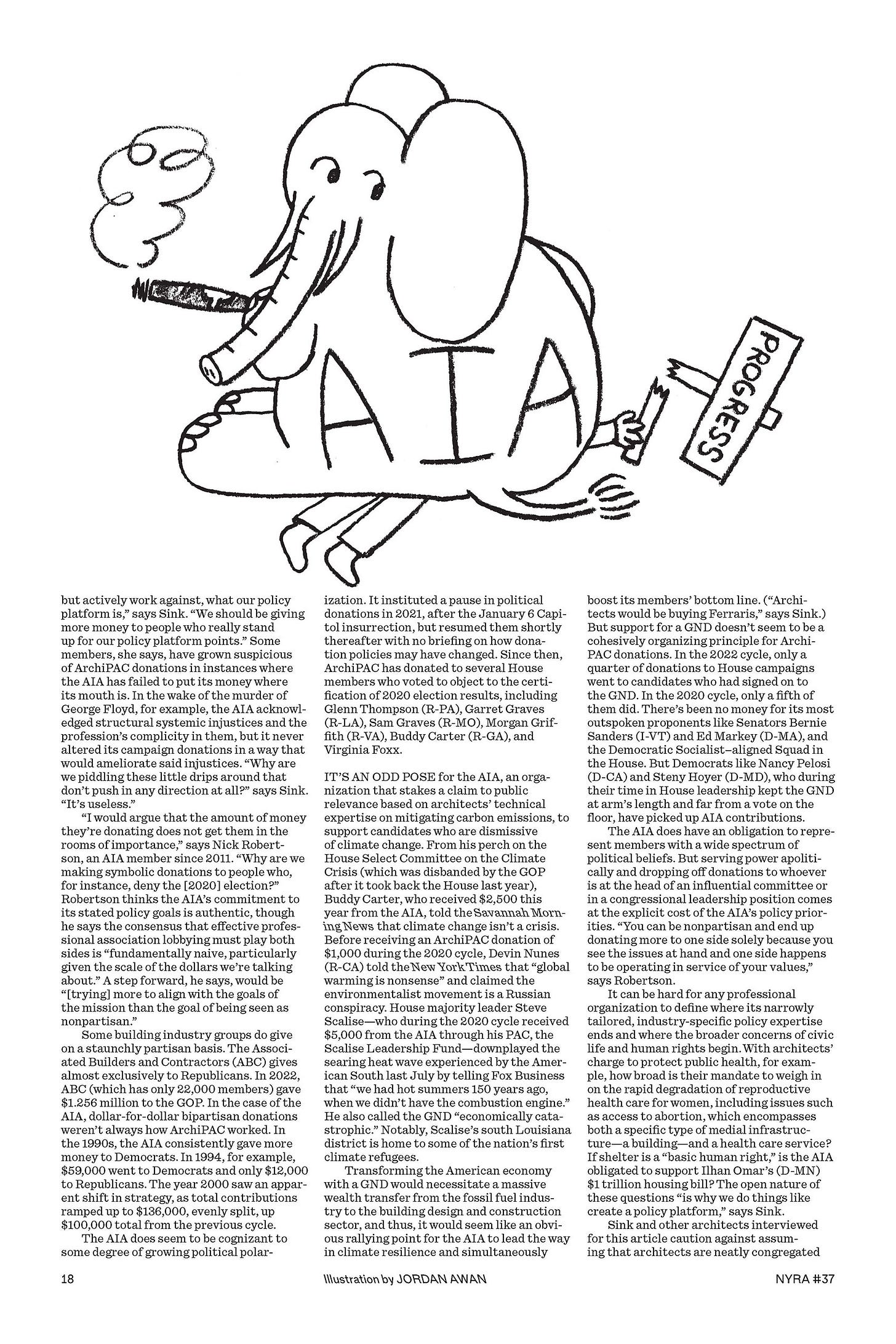
The cover of NYRA #37 looks like every New York diner. All the trappings are there: the clock on the back wall, the round vinyl stools, and, if you flip to the back, the enormous New York sign running across the wall. The space lends itself almost too well to being turned into a cartoon. As NYRA learned from an SVA student during one of our weekly workshops, that’s no accident. The shop in question, Johny’s Luncheonette on 25th Street, was the object of a Ty Pennington makeover in the 2016 season of American Diner Revival. The diner-core decor was intentional, a knowing reference to the image of these New York institutions that people have come to know, mostly, through their TV screens.
Johny’s story is a good example of one of the motivating principles of NYRA: that if you look at a space just slightly askew, you might find a whole new way of understanding the world.⬤
—Marianela D’Aprile
To receive Issue #37, subscribe and we will put a copy in the mail for you.
In the current issue our writers investigated everything from organizing architectural workers to public toilets, from houses in Queens to the Marxist project. Scroll down for a sampling…

CLAUDIA ROSS HYPES BARBIE’S HOUSE
The Dreamhouse’s multiplicity is not a bug but a feature: its architecture enables users to play with and through the problems proposed by the house itself. The plastic mansion anticipates its own destruction, but that destruction is never fully realized; the Dreamhouse’s generic malleability remains its ultimate defense.
AARON TIMMS GOES OFF ON THE ORIGINAL HOSTILE ARCHITECTURE
Institutional neglect of the public toilet has not made New York any cleaner. The streets are as stinky and messy as ever, and the city’s administration remains a confusing jumble of rupophobia and mysophilia—reflecting, perhaps, America’s long history of cultural oscillation between prudishness and profanity.
THOMAS DE MONCHAUX SAVES PENN STATION. AGAIN.
By the reduced standards with which we are obliged to evaluate public-facing architectural projects in New York City, a good enough design of the kind ASTM offers for Penn Station—sufficiently dutiful and sufficiently competent, addressing daily human experience and landmark urban scale—would be a great triumph.

MARISA CORTRIGHT WONDERS WHAT ARCHITECTURE UNIONS MIGHT DEMAND
Architectural workers could address the larger social conditions that might have spurred them toward organizing in the first place while also taking into account their more immediate needs. This approach, known as “bargaining for the common good,” brings union members into conversation with community members to include in their contract negotiations items that benefit society more broadly.
ZACH MORTICE EXAMINES THE AIA’S POLITICAL DONATIONS
The AIA can alienate part of its membership and invigorate its countervailing demographic with the reasonable conclusion that actually achieving its policy goals, widely believed to be required to sustain human civilization long term, will provide a massive windfall to architects. Or it can play both sides for a few thousand dollars a pop.
ERIC SCHWARTAU IS A RENAISSANCE MAN
Whether you’re a NIMBY, YIMBY, or a FURBY, there is a subjective quality to preservation. The past is always fading away, escaping our grasp. Nothing lasts forever, but everything eventually becomes interesting.
KATE ARONOFF AND JAKE BITTLE TALK CLIMATE ACTION
The last few years has also shown pretty clearly that companies just won’t invest in things that they do not expect to make money from. Unfortunately, that category includes lots of things that are essential to cutting carbon: sequestering carbon underground forever isn’t exactly a glamorous business, and it’s hard to imagine Exxon or Chevron pivoting to primarily being carbon sink landlords.
SAMUEL MEDINA GOES ROUND HOUSES IN QUEENS
Rarely is the sagacity of property lines called into question, and not just in Herrin-Ferri’s book, though there they engender a medium-specific buoyancy independent from the pathologies they enact in the real world.
KATE WAGNER IS JEALOUS OF A.V. MARRACCINI
While I have written about the importance of criticism in an increasingly uncritical world—that is, the importance of criticism to a collective other—I rarely give any thought to what criticism means to me, Kate Wagner, the individual.
ENRIQUE RAMIREZ GETS LOST UPSTATE
An architectural history of the materials that shaped the New York City metropolitan area awaits us. Think of a book like William Cronon’s Nature’s Metropolis: Chicago and the Great West. Now think of something bigger, grander, something befitting New York.

SEAN TATOL TALLIES UP DAN GRAHAM’S QUIRKS
Footnotes invariably correct Graham’s claim—appearing in numerous places in the book—that Flavin and LeWitt were influenced by a nonexistent Russian Constructivism show that was supposed to have happened at MoMA while they worked as security guards there. He has an odd tendency to rattle off facts with unnecessary supplementary information, such as telling Kim Gordon that “Sunday Morning” is a song by the Velvet Underground.
ELLEN PEIRSON PONDERS WHAT EXHIBITIONS CAN DO
In a time of multiple crises and an increased understanding of architecture’s complicity in spatial violence that relates to race, gender, wealth, and labor conditions, what and who is an architectural exhibition for?
WILL ORR ASSAYS PIER VITTORIO AURELI’S LATEST TREATISE
Project has ceased to be a byword for the insulation of architectural intent from exogenous pressures—valid precisely as an end in itself—and instead describes a sort of twist on planning, augmented with management.
OWEN HATHERLEY IS UNDERWHELMED BY THE “IDEAL COMMUNITY CITY”
The montage is fascinating and by now exceptionally nostalgia-inducing—especially alongside the authors’ many schematic diagrams and city plans, it could easily be assembled into a charming, sub-Eames slideshow—but it explains little.
LILY PUCKETT QUESTIONS THE GUGGENHEIM’S NATURE
Besides New York, Wright loudly hated art in general, believing instead that walls themselves should be the main attraction. The Guggenheim is a tribute to this mindset.

New York Review of Architecture reviews architecture in New York. Our editor is Samuel Medina, our deputy editor is Marianela D’Aprile, and our publisher is Nicolas Kemper.
To pitch us an article or ask us a question, write to us at: editor@nyra.nyc.
For their support, we would like to thank the Graham Foundation and our issue sponsors, Tod Williams Billie Tsien Architects, Elise Jaffe and Jeffrey Brown, and Thomas Phifer.
To support our contributors and receive NYRA by post, subscribe here.


